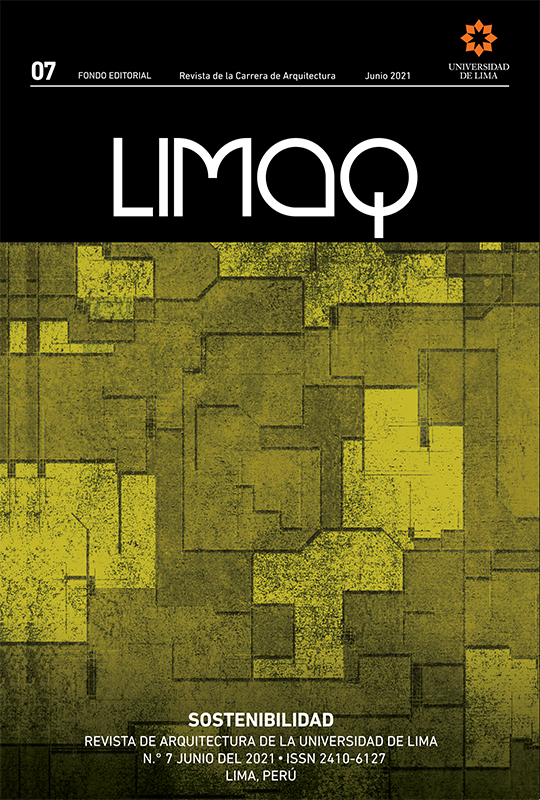Hacia la sostenibilidad desde la arquitectura y la ecosofía: lazos entre la ecología mental, la neurociencia emocional y el espacio
Palabras clave:
ecosofía, ecología mental, bioarquitectura, economía del comportamiento, neurociencia, transdisciplinar, ética en la arquitectura, sostenibilidadResumen
DOI: https://doi.org/10.26439/limaq2021.n007.5177
El presente artículo surge de la revisión de libros e investigaciones relacionados con la sostenibilidad, desde los ejes de la arquitectura, filosofía, psicología y neurociencia. Aborda la problemática ecológica desde la propuesta ecosófica (ecología medioambiental, social y mental) de Félix Guattari y plantea caminos transdisciplinares para su realización. Asimismo, expone la relación de la ecología mental con la dimensión existencial, artística y ética de la arquitectura, utilizando como soporte la neurociencia emocional. Finalmente, plantea la sensibilización del diseño a través del conocimiento transdisciplinar del ser humano, para lograr así una ideación sensible en las propuestas arquitectónicas.
Descargas
Referencias
Aggleton, J. P., y Mishkin, M. (1986). The Amygdala: Sensory Gateway to the Emotions. En R. Plutchik y H. Kellerman (Eds.), Emotion: Theory, Research and Experience, vol. 3: Biological Foundations of Emotion. Orlando: Academic Press.
Bachelard, G. (1957). La poétique de l’espace. París: Presses Universitaires de France.
Balmer, A. S., y Martin, P. (2008). Synthetic biology: Social and ethical challenges. Nottingham: Institute for Science and Society University of Nottingham.
Barrett, P., Davies, F., Zhang, Y., y Barrett, L. (2017). The Holistic Impact of Classroom Spaces on Learning in specific subjects. Environment and Behavior, 49(4), 425-451. doi: 10.1177/0013916516648735
Biran, A., Schmidt, W. P., Varadharajan, K. S., Rajaraman, D., Kumar, R., Greenland, K., Gopalan, B., Aunger, R., y Curtis, V. (2014). Effect of a Behavior-Change Intervention on Handwashing with Soap in India (SuperAmma): A Cluster-Randomised Trial. The Lancet Global Health, 2(3), e145-e154.
Cahill, L., Babinsky R., Markowitsch, H. J., y McGaugh, J. L. (1995). Amygdala and Emotional Memory. Nature, 377, 295-296.
Damasio, A. R. (2014). El error de Descartes: La emoción, la razón y el cerebro humano. Barcelona: Editorial Planeta.
Diéguez, A. (2013). Biología sintética, transhumanismo y ciencia bien ordenada. Viento Sur, (131), 71-80.
Farinella, M., y Roš, H. (2013). Neurocomic. Londres: Nobrow Press.
Foucault, M. (2009). Vigilar y castigar: nacimiento de la prisión. Buenos Aires: Siglo Veintiuno Editores (año de publicación del libro original, 1975).
Guattari, F. (1996). Las tres ecologías. Valencia: Pre-Textos.
Guenther, K. (2016). Between Clinic and Experiment: Wilder Penfield’s Stimulation Reports and the Search for Mind, 1929-55. Canadian Bulletin of Medical History, 33(2), 281-320. doi: 10.3138/cbmh.33.2.148-27012015
Haushofer, J., John, A., y Orkin, K. (2019). Can Simple Psychological Interventions Increase Preventive Health Investment? National Bureau of Economic Research, (NBER), (Working Paper n.° 25731).
Haushofer, J., y Metcalf, J. C. E. (2020). Combining Behavioral Economics and Infectious Disease Epidemiology to Mitigate the COVID-19 Outbreak. New Jersey: Princeton University.
Haverinen-Shaughnessy, U., y Shaughnessy, R. J. (2015). Effects of Classroom Ventilation Rate and Temperature on Students’ Test Scores. PloS ONE, 10(8), e0136165.
Herz, R. S., y Schooler, J. W. (2002). A Naturalistic Study of Autobiographical Memories Evoked by Olfactory and Visual Cues: Testing the Proustian Hypothesis. American Journal of Psychology, 115(1), 21-32.
Hursh, S. R. (1984). Behavioral Economics. Journal of the Experimental Analysis of Behavior, 42(3), 435-452.
Hussam, R., Rabbani, A., Reggiani, G., y Rigol, N. (2017). Rational Habit Formation: Experimental Evidence from Handwashing in India. Harvard Business School, Working Paper 18-030.
Karing, A. (2018). Social Signaling and Childhood Immunization: A Field Experiment in Sierra Leone. Berkeley: University of California.
Küller, R., Mikellides, B., y Janssens, J. (2009). Color, Arousal, and Performance-A Comparison of Three Experiments. Color Research & Application, 34(2), 141-152.
Lehrer, J. (2010). Proust y la neurociencia: Una visión única de ocho artistas fundamentales en la modernidad. Barcelona: Ediciones Paidós.
Mallgrave, H. F. (2011). The Architect’s Brain: Neuroscience, Creativity, and Architecture. New Jersey: John Wiley & Sons.
Mehta, R. K., Shortz, A. E., y Benden, M. E. (2015). Standing Up for Learning: A Pilot Investigation on the Neurocognitive Benefits of Stand-Biased School Desks. International Journal of Environmental Research and Public Health, 13(1), 59. doi:10.3390/ijerph13010059
Mogas-Soldevila, L., Duro-Royo, J., y Oxman, N. (2014). Water-Based Robotic Fabrication: Large-Scale Additive Manufacturing of Functionally Graded Hydrogel Composites via Multichamber Extrusion. 3D Printing and Additive Manufacturing, 1(3), 141-151.
Mullainathan, S., y Thaler, R. H. (2000). Behavioral Economics. National Bureau of Economic Research, (NBER), (Working Paper n.° 7948).
Norberg-Schulz, C. (1975). Existencia, espacio y arquitectura. Barcelona: Blume.
Oxman, N. (2011). Variable Property Rapid Prototyping: Inspired by Nature, Where Form Is Characterized by Heterogeneous Compositions, the Paper Presents a Novel Approach to Layered Manufacturing Entitled Variable Property Rapid Prototyping. Virtual and physical prototyping, 6(1), 3-31. doi: 10.1080/17452759.2011.558588
Oxman, N. (2015). Templating Design for Biology and Biology for Design. Architectural Design, 85(5), 100-107.
Pallasmaa, J. (2014). La imagen corpórea. Barcelona: Editorial Gustavo Gili.
Pallasmaa, J. (2016). Habitar. Barcelona: Editorial Gustavo Gili.
Penfield, W., y Rasmussen, T. (1950). The Cerebral Cortex of Man: A Clinical Study of Localization of Function. New York: Macmillan.
Pringle, H. (2013). The Origins of Creativity. Scientific American, 308(3), 36-43.
Steidle, A., y Werth, L. (2013). Freedom From Constraints: Darkness and Dim Illumination Promote Creativity. Journal of Environmental Psychology, 35, 67-80.
Wadley, L., Sievers, C., Bamford, M., Goldberg, P., Berna, F., y Miller, C. (2011). Middle Stone Age Bedding Construction and Settlement Patterns at Sibudu, South Africa. Science, 334(6061), 1388-1391.
Wargocki, P., y Wyon, D. P. (2007). The Effects of Moderately Raised Classroom Temperatures and Classroom Ventilation Rate on the Performance of Schoolwork by Children (RP-1257). HVAC&R Research, 13(2), 193-220. doi: 10.1080/10789669.2007.10390951
Watson, J., Dreibelbis, R., Aunger, R., Deola, C., King, K., Long, S., Chase R. P. y Cumming, O. (2019). Child’s Play: Harnessing Play and Curiosity Motives to Improve Child Handwashing in a Humanitarian Setting. International Journal of Hygiene and Environmental Health, 222(2), 177-182.
Weinthal, L. (Ed.). (2011). Toward a New Interior: An Anthology of Interior Design Theory. New York: Princeton Architectural Press.



